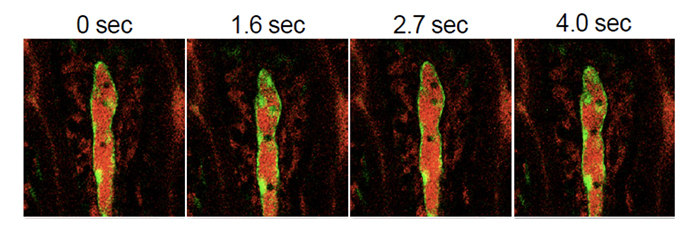Graduate School of Nanoscience and Technology’s Professor Pilhan Kim and his team at Korea Advanced Institute of Science and Technology (KAIST) has developed a new imaging technique to visualize lipid drainage through the lacteal in the small intestine. They have revealed the contractile movement of the lacteal and its role in lipid drainage.
The small intestine actively digests food and absorbs nutrients. The luminal surface of the small intestine is densely covered with villi, which provide an extensive absorptive surface area. Lacteals are initial lymphatic vessels located at the center of each villus and provide essential transport routes for lipids and other lipophilic molecules. However, the dynamic process of the absorption and transport of lipids from absorptive cells, also known as enterocytes, of the villus surface to lacteals has been mostly unknown.
High-resolution intravital imaging to visualize the lipid drainage inside the villi of the live small intestine is challenging due to the continuous and highly active movement of the intestinal loop. The research team adapted a custom-designed video-rate laser scanning confocal microscopy system to clearly capture the lipid drainage inside the moving villi. In addition, the team newly implemented an imaging chamber for the live small intestine, which can eliminate the motion artifact and maintain the natural environment for the exposed intestine tissue under imaging.
By utilizing the new imaging technique, the team succeeded to visualize not only the drainage of fluorescent-tagged fatty acids but also the drainage of various hydrophilic and lipophilic fluorescent molecules and cancer drug as can be seen in Fig. 1.

Surprisingly, during the intravital imaging of the drainage of various molecules through the lacteal in real-time, a contractile movement of lacteal was unexpectedly discovered (Fig. 2). It has been widely believed that the initial lymphatic vessels including the lacteal in the small intestine only serve as a passive sewer of interstitial fluid. However, the discovery of contractile movement of lacteals implies that lacteals possess unique characteristics that distinguish it from the common initial lymphatic system. In addition, it also suggests that lacteals do not merely serve as a passive conduit but as an active pump that transports lipids.

The team also demonstrated that the contraction of lacteal is directly involved in lipid drainage. In addition, the smooth muscles that surround each lacteal were responsible for contractile dynamics and that lacteal contraction was ultimately controlled by the autonomic nervous system.
Professor Kim stated, “A better understanding of underlying mechanism in the transport of lipid and lipophilic molecules through lacteal can provide a new insight for drug development. Drug delivery via lymphatic system can circumvent the first-pass metabolism in the liver, which will greatly improve the bioavailability of orally ingested drugs.”
This study was published in Journal of Clinical Investigation (JCI) in November 2015 and was also highlighted in “JCI This Month.” This work was produced in conjunction with Professor Gou Young Koh’s laboratory in the Graduate School of Medical Science and Engineering at KAIST.







